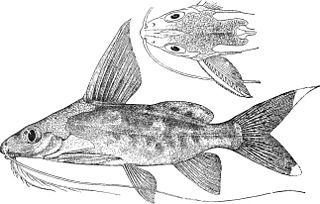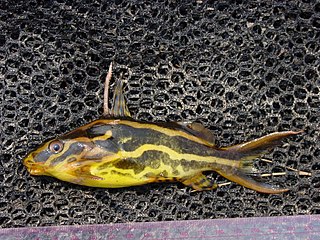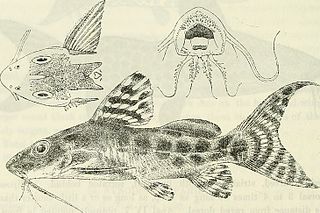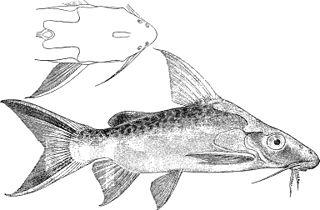
Synodontis membranaceus, known as the moustache catfish, is a species of upside-down catfish that is native to northern Africa. It was first described by French naturalist Geoffroy Saint-Hilaire in 1809 as Pimelodus membranaceus, from specimens obtained in the Nile River. The species name membranaceus refers to membranes present on the barbels of the fish.
Synodontis dhonti is a species of upside-down catfish endemic to the Democratic Republic of the Congo where it is only known from Lake Tanganyika. It was first described by Belgian-British zoologist George Albert Boulenger in 1917, based upon a single specimen collected from Lake Tanganyika at Kilewa Bay, in what is now the Democratic Republic of the Congo. The species is named after M.G. Dhont-De Bie, who accompanied the collector, Dr. L. Stappers, on his expedition. At one point, identified specimens Synodontis irsacae was believed to be juvenile individuals of S. dhonti and the two were considered to be the same species, but further research has identified differences between the two species and they are once again recognized as distinct from each other.

Synodontis petricola, known as the cuckoo catfish, or the pygmy leopard catfish, is a species of upside-down catfish endemic to Burundi, Zambia, the Democratic Republic of the Congo, and Tanzania where it is only known from Lake Tanganyika. It was first described by Belgian ichthyologist Hubert Matthes in 1959. The species name "petricola" is derived from a combination of the Latin petra, meaning stone or rock, and the Latin cola, meaning inhabitant. This refers to the rocky environment where this species is found.

Synodontis alberti, the bigeye squeaker, Albert's syno, bigspotted squeaker, or high-fin synodontis, is a species of upside-down catfish native to the Congo Basin of Cameroon, the Democratic Republic of the Congo and the Republic of the Congo. It was originally described in 1891 by Belgian ichthyologist Louise Schilthuis after its discovery in the Malebo Pool of the Congo River.
Synodontis albolineatus, known as the mustard catfish, or the mustard squeaker, is a species of upside-down catfish native to Gabon and Cameroon, where it occurs in the Ntem and Ivindo rivers. It was first described by French zoologist Jacques Pellegrin in 1924, based upon a holotype discovered in the Djoua River at Madjingo, Gabon. The holotype specimen resides in the Musee National d' Histoire Naturelle de Paris. The specific name "albolineatus" is a composite from the Latin word albus for "white" and the Latin word linea for "line", which refers to the white midlateral stripe of the species.

Synodontis batesii is a species of upside-down catfish native to rivers of Cameroon, the Democratic Republic of the Congo, Equatorial Guinea and Gabon. It was first collected by G. L. Bates and described by Belgian-British zoologist George Albert Boulenger in 1907, based upon holotypes discovered in the Dja River, near Bitye in Cameroon. The specific name "batesii" refers to the name of the collector of the first specimen.

Synodontis caudalis, known as the filament tailed synodontis, or the whiptail synodontis, is a species of upside-down catfish native to the Democratic Republic of the Congo. It was first described by Belgian-British zoologist George Albert Boulenger in 1899, from specimens collected in what is now the Democratic Republic of the Congo. The species name caudalis comes from the Latin word cauda, meaning tail, and refers to the elongated filaments in the caudal fin of the species.

Synodontis congicus is a species of upside-down catfish native to the Democratic Republic of the Congo and the Republic of the Congo where it occurs in the upper and middle Congo Basin. It was first described by Belgian ichthyologist Max Poll in 1971. The first specimen was found near the town of Gangala-na-Bodio, Democratic Republic of the Congo, in the Dungu River. The meaning of the specific name "congicus" is "From the Congo".

Synodontis depauwi is a species of upside-down catfish that is endemic to the Democratic Republic of the Congo where it can be found in Stanley Pool. It was first described by British-Belgian zoologist George Albert Boulenger in 1899, from specimens collected in Stanley Pool, in the Democratic Republic of the Congo. The species name depauwi is in honour of the "conservateur des collections de l'Université libre de Bruxelles", Louis De Pauw.

Synodontis flavitaeniatus, known as the orangestriped squeaker, the chocolatestriped squeaker, the yellowstriped squeaker, and the pyjama Syno, is a species of upside-down catfish native to the Democratic Republic of the Congo and the Republic of the Congo where it is found in the lower and central Congo Basin. It was first described by Belgian-British zoologist George Albert Boulenger in 1919. The holotype was collected from the Ruki River at Eala, in the Democratic Republic of the Congo. The meaning of the specific name "flavitaeniatus" is "yellow stripes".

Synodontis greshoffi is a species of upside-down catfish native to the Congo Basin of Cameroon, the Democratic Republic of the Congo and the Republic of the Congo. It was first collected by M.A. Greshoff in Pool Malebo on the upper Congo River, and the species was named for him by the author of the first paper written about the species, Belgian ichthyologist Louise Schilthuis, in 1891.

Synodontis nigromaculatus, known as the spotted squeaker, the blackspotted squeaker, or the speckled squeaker, is a species of upside-down catfish that is found widely in southern Africa. It has been identified in Angola, Botswana, the Democratic Republic of the Congo, Mozambique, Namibia, South Africa, Zambia, and Zimbabwe. It was first described by British-Belgian zoologist George Albert Boulenger in 1905, from specimens collected in Lake Bangweulu in Zambia.

Synodontis notatus, known as the onespot squeaker, the one-spot synodontis, or the domino syno, is a species of upside-down catfish native to the Congo Basin of the Democratic Republic of the Congo, and the Republic of the Congo. It was first described by French zoologist Léon Vaillant in 1893. The specific name "notatus" comes from the Latin word for "marked", as with a spot.

Synodontis ornatipinnis, known as the barfin synodontis, is a species of upside-down catfish that is native to the Congo Basin of the Democratic Republic of the Congo and Zambia. It was first described by British-Belgian zoologist George Albert Boulenger in 1899, from specimens collected in Mbandaka, on the Congo River in what is now the Democratic Republic of the Congo. The species name ornatipinnis means "ornate fins".

Synodontis pleurops, known as the Congo squeaker, the bigeye squeaker, or the bug eyed synodontis, is a species of upside-down catfish native to the upper Congo Basin of Cameroon, the Democratic Republic of the Congo and the Republic of the Congo. It was first described by the Belgian-British zoologist George Albert Boulenger in 1899, based upon a holotype discovered at the Boyoma Falls, in the Democratic Republic of the Congo.

Synodontis robbianus, known as the russet synodontis, is a species of upside-down catfish that is native to Nigeria where it is found in the Cross and lower Niger Rivers. It was first described by John Alexander Smith in 1875, from specimens collected in the Calabar River, Nigeria. The species name robbianus is named after Rev. Alexander Robb, a Scottish missionary, who collected the original species samples.

Synodontis schoutedeni, known as the yellow marbled Synodontis, is a species of upside-down catfish native to the Congo Basin of the Democratic Republic of the Congo and the Republic of the Congo. It was first described by Belgian ichthyologist Lore Rose David in 1936, based upon a holotype discovered in Basongo, in what is now the Democratic Republic of the Congo. The specific name "schoutedeni" is named after the Belgian zoologist Henri Schouteden.

Synodontis serratus, known as the shield-head squeaker, is a species of upside-down catfish that is native to the Nile basin of the Democratic Republic of the Congo, Egypt, Ethiopia and Sudan. It was first described by German naturalist and explorer Eduard Rüppell in 1829, from specimens obtained near Cairo, Egypt. The species name serratus comes from the Latin word serra, meaning "saw", which refers to the serrated pectoral spines of the species.

Synodontis smiti, known as the longtail Synodontis, or Smit's Synodontis, is a species of upside-down catfish that is endemic to the Democratic Republic of the Congo where it is found in the middle and upper Congo Basin. It was first described by British-Belgian zoologist George Albert Boulenger in 1902, from specimens obtained in the Ubangi River at Banzyville. The species name smiti is named for Pierre Jacques Smit, who illustrated the plates in Boulenger's works.
Synodontis tanganyicae is a species of upside-down catfish endemic to the Democratic Republic of the Congo, Zambia, and Tanzania, where it is only known from Lake Tanganyika. It was first described by Russian-American ichthyologist Nikolai Andreyevich Borodin in 1936, from specimens collected at Kasaga, in what is now the Democratic Republic of the Congo. The species name tanganyicae comes from the habitat of the species, Lake Tanganyika.


















